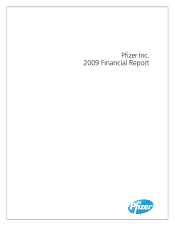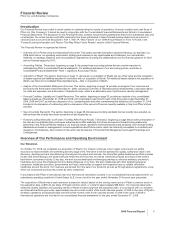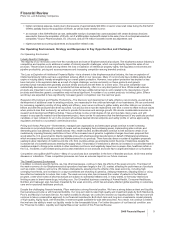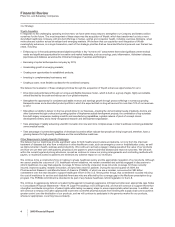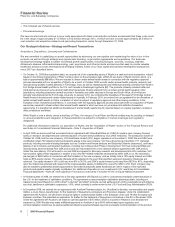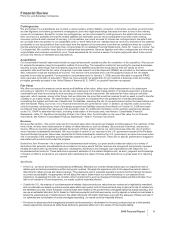Pfizer 2009 Annual Report Download - page 5
Download and view the complete annual report
Please find page 5 of the 2009 Pfizer annual report below. You can navigate through the pages in the report by either clicking on the pages listed below, or by using the keyword search tool below to find specific information within the annual report.
Financial Review
Pfizer Inc. and Subsidiary Companies
Ohigher net interest expense, mainly due to the issuance of approximately $24 billion in senior unsecured notes during the first half of
2009 to partially finance the acquisition of Wyeth, as well as lower interest income;
Oan increase in the 2009 effective tax rate, attributable mainly to increased tax costs associated with certain business decisions
executed to finance the acquisition of Wyeth, net of a $556 million tax benefit related to the sale of one of our biopharmaceutical
companies, Vicuron Pharmaceuticals, Inc. (Vicuron), and a $174 million favorable income tax adjustment; and
Ohigher purchase accounting adjustments and acquisition-related costs.
Our Operating Environment, Strategy and Responses to Key Opportunities and Challenges
Our Operating Environment
Industry-Specific Challenges
The majority of our revenues come from the manufacture and sale of Biopharmaceutical products. The biopharmaceutical industry is
competitive and requires us to address a number of industry-specific challenges, which can significantly impact the sales of our
products. These factors include among others: the loss or expiration of intellectual property rights, the regulatory environment and
pipeline productivity, pricing and access pressures and increasing competition among branded products.
The Loss or Expiration of Intellectual Property Rights—As is inherent in the biopharmaceutical industry, the loss or expiration of
intellectual property rights can have a significant adverse effect on our revenues. Many of our products have multiple patents that
expire at varying dates, thereby strengthening our overall patent protection. However, once patent protection has expired or has
been lost prior to the expiration date as a result of a legal challenge, we lose exclusivity on these products and generic
pharmaceutical manufacturers generally produce similar products and sell them for a lower price. This price competition can
substantially decrease our revenues for products that lose exclusivity, often in a very short period of time. While small molecule
products are impacted in such a manner, biologics currently have additional barriers to entry related to the manufacture of such
products and therefore generic competition may not be as significant. A number of our current products, including Lipitor, Effexor
and Zosyn are expected to face significantly increased generic competition over the next few years.
Regulatory Environment and Pipeline Productivity—The discovery and development of safe, effective new products, as well as the
development of additional uses for existing products, are necessary for the continued strength of our businesses. We are confronted
by increasing regulatory scrutiny of drug safety and efficacy, even as we continue to gather safety and other data on our products,
before and after the products have been launched. Our product lines must be replenished over time in order to offset revenue losses
when products lose their exclusivity, as well as to provide for revenue and earnings growth. We devote considerable resources to
research and development (R&D) activities. These activities involve a high degree of risk and may take many years, and with
respect to any specific research and development project, there can be no assurance that the development of any particular product
candidate or new indication for an in-line product will achieve desired clinical endpoints and safety profile or will be approved by
regulators and lead to a successful commercial product.
Pricing and Access Pressures—Governments, managed care organizations and other payer groups continue to seek increasing
discounts on our products through a variety of means such as leveraging their purchasing power, implementing price controls, and
demanding price cuts (directly or by rebate actions). Also, health insurers and benefit plans continue to limit access to certain of our
medicines by imposing formulary restrictions in favor of the increased use of generics. Legislative changes have been proposed that
would allow the U.S. government to directly negotiate prices with pharmaceutical manufacturers on behalf of Medicare beneficiaries,
which we expect would restrict access to and reimbursement for our products. There have also been a number of legislative proposals
seeking to allow importation of medicines into the U.S. from countries whose governments control the price of medicines, despite the
increased risk of counterfeit products entering the supply chain. If importation of medicines is allowed, an increase in cross-border trade in
medicines subject to foreign price controls in other countries could occur and negatively impact our revenues. Also, healthcare reform in
the U.S., if enacted, could increase pricing and access restrictions on our products and could have a significant impact on our business.
Competition among Branded Products—Many of our products face competition in the form of branded products, which treat similar
diseases or indications. These competitive pressures can have an adverse impact on our future revenues.
The Overall Economic Environment
In addition to industry-specific factors, we, like other businesses, continue to face the effects of the weak economy. The impact of
the weak economy on our Biopharmaceutical operations has been largely in the U.S. market, affecting the performance of products
such as Lipitor, Celebrex and Lyrica. We believe that patients, experiencing the effects of the weak economy, including high
unemployment levels, and increases in co-pays sometimes are switching to generics, delaying treatments, skipping doses or using
less effective treatments to reduce their costs. The weak economy also has increased the number of patients in the Medicaid
program, under which sales of pharmaceuticals are subject to substantial rebates and, in many states, to formulary restrictions
limiting access to brand-name drugs, including ours. Our Diversified business consisting of Animal Health, Consumer Healthcare,
Nutrition and Capsugel, also has been impacted by the weak economy, which has adversely affected global spending on veterinary
care and on personal healthcare products.
Despite the challenging financial markets, Pfizer maintains a strong financial position. We have a strong balance sheet and liquidity
that we believe provide us with financial flexibility. Our long-term debt is rated high quality and investment grade by both Standard &
Poor’s and Moody’s Investors Service. As market conditions change, we continue to monitor our liquidity position. We have and will
continue to take a conservative approach to our financial investments. Both short-term and long-term investments consist primarily
of high-quality, highly liquid, well-diversified, investment-grade available-for-sale debt securities. As a result, we continue to believe
that we have the ability to meet our liquidity needs for the foreseeable future. For further discussion of our financial condition, see
the “Financial Condition, Liquidity and Capital Resources” section of this Financial Review.
2009 Financial Report 3

